This Mixed Grain Bread with Poolish, fermented with an overnight poolish, and flavored with whole wheat, and gluten-free flour, is a great way to clean out your cupboard.
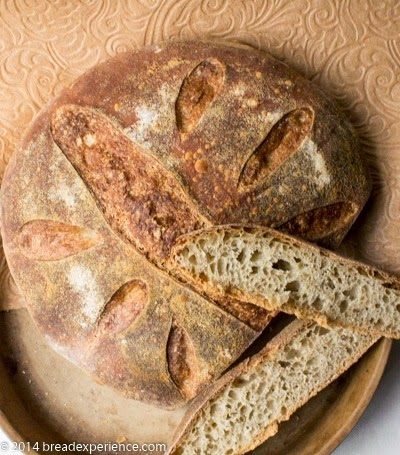
Do you have bags of flour with just a little bit left in them? Then it’s time to clean out your cupboard and use up those bags of flour you’ve been storing. Why not create a new loaf or revisit an old favorite, but make it new by substituting a different flour?
You know the saying “out with the old and in with the new?” It’s a great way to begin the new baking year as well.
I have bags and containers filled with different types of flour in my refrigerator, freezer, and cupboards so when I read a blog post recently by Jarkko Lane, the editor of the Bread Magazine, I took him up on his challenge to clean out the flour cupboard.
He encouraged us to take a look at our flour shelves to see if we had any bag ends that needed to be used before they reached their best-before date and began to go rancid. He called his loaf Bag End Bread.
I thought that was a wonderful idea! So I decided to create my version and use up some of my flour in the process. I looked in my freezer first since the flour in there had been resting the longest. I picked a couple of different grains to make things interesting, then I set out to create a loaf using these flours.
I wanted to make a loaf that utilized a poolish and incorporated some whole wheat and gluten-free flour. To accomplish this, I revisited one of my favorite breads, White Bread with an Overnight Poolish, from Ken Forkish’s Flour, Water, Salt & Yeast.
He has mixed grain formulas in the book as well, but I wanted to make my own so I started with the white version and went from there. I used a mixture of bread flour, whole wheat, Teff, and millet flour.
I baked the loaf in my La Cloche. I hadn’t used this stoneware baker in a while, but it works well for this type of bread. The bread turned out to be a chewy, yet flavorful loaf.
Mixed Grain Bread with Poolish — Clean out the Cupboard Loaf
Adapted from: Flour Water Salt Yeast: The Fundamentals of Artisan Bread and Pizza by Ken Forkish
Makes: One Loaf
Poolish:
| Ingredient | Quantity | Baker’s % |
| White bread flour | 250 grams | 100% |
| Water | 250 grams 80 degrees F. | 100% |
| Instant dried yeast | 0.4 grams |
Final Dough:
| Ingredient | Final Dough Mix Quantity | Baker’s % |
| White bread flour | 125 grams | 80% |
| Whole Wheat flour | 70 grams | 14% |
| Teff flour | 15 grams | 3% |
| Millet flour | 15 grams | 3% |
| Water | 125 grams 105 degrees F. | 50% |
| Fine sea salt | 10 grams | 2.0% |
| Instant dried yeast | 1.6 grams | |
| Poolish | All of the above | 50% |
1) Start the Poolish
You can start the poolish the evening or the day before you plan to bake the bread; whatever suits your schedule. I planned to bake this bread Saturday afternoon so instead of utilizing an overnight poolish, I started the poolish Friday morning and made the final dough Friday night, then I placed the dough in a proofing basket and let it rest in the refrigerator until I was ready to bake the bread Saturday afternoon.
To make the poolish, whisk the flour and yeast together in a large bowl and add the 80 degrees F. water. Mix by hand or with a wooden spoon until it is thoroughly blended. Cover the bowl with plastic wrap and let it sit at room temperature (65 to 70 degrees F.) for 12 to 14 hours. When the poolish is ready, it should be bubbly and almost tripled in volume.
2) Mix the Final Dough
Later that evening or the next day, after the poolish is fully mature, whisk together the flour, salt, and instant yeast in a large bowl. Pour the water (105 degrees F.) around the edges of the poolish to loosen it from the bowl. Then pour the water/poolish mixture into the flour mixture and use a spatula or wooden spoon to mix the poolish with the flour.
Using wet hands, mix the dough by folding it to thoroughly incorporate all of the ingredients (refer to my post on making Tartine Country Bread) The dough should be around 74 – 75 degrees F.
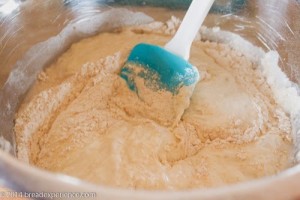 |
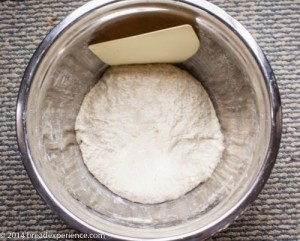 |
3) Bulk Fermentation
Let the dough rest for 2 to 3 hours after mixing. During this time, do two or three folds during the first hour after mixing the dough.
Turn the dough out onto the counter or a wooden board, cover, and bench rest for 10 min.
Prepare a round banneton or linen-lined basket or bowl by dusting it with brown or white rice flour. Shape the dough into a boule, and place it seam side up in your prepared basket. Cover with plastic wrap or place it in a plastic bag and let it cold ferment in the refrigerator (12 – 24 hours).
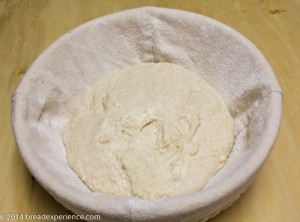 |
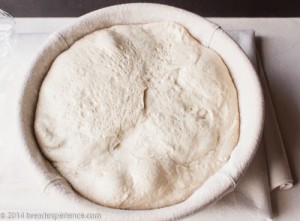 |
4) Bake the Loaf
When you are ready to bake the loaf, preheat the oven to 500F (260C) for at least 40 minutes with a La Cloche, Dutch Oven, or ceramic bread baker on the middle rack.
You’ll bake the dough directly from the fridge so don’t remove the proofing basket until you are ready to flip the loaf into the pot.
Carefully flip the loaf from the basket into the preheated bread baker, score the top of the loaf, place the lid on the unit, and put it in the oven.
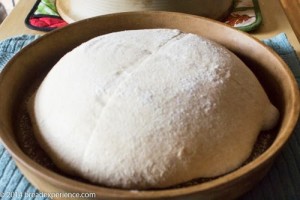 |
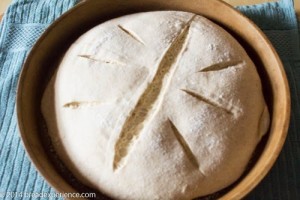 |
Reduce the oven temperature to 475F (245C) and bake the loaf covered for 25 minutes. After 25 minutes, carefully remove the lid, reduce oven temp to 450F (232C), and continue baking for an additional 25 minutes, or until the crust turns dark brown.
Cool the loaf on a wire rack for 90 minutes before slicing.
I’m sending this Mixed Grain Cupboard Bread with Poolish to be yeastspotted.
I was very pleased with how this clean-out-the-cupboard loaf turned out. I like the color and texture. Next time, I might try a little bit more whole wheat or increase the amount of Teff or Millet to see how it changes the texture and flavor.
Happy Baking!
Cathy
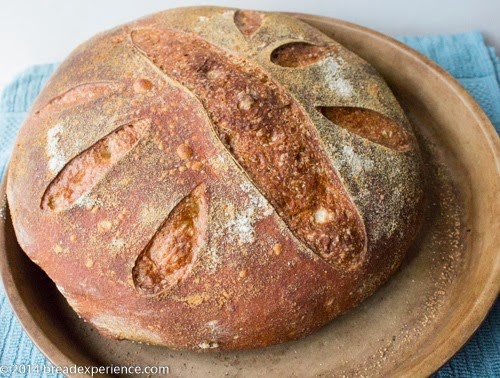
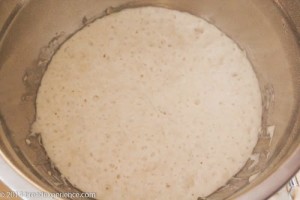
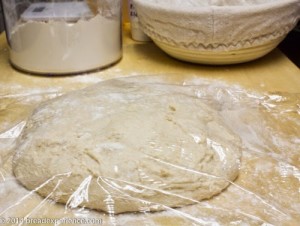
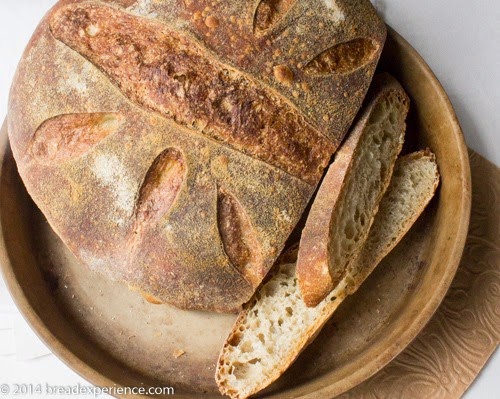
MyKitchenInHalfCups says
This absolutely makes me smile as I’m often using odd measures of flours than just need to be used. This looks to be an awesome loaf.
Cathy W. says
Thanks Tanna! This was a fun one to make and eat!